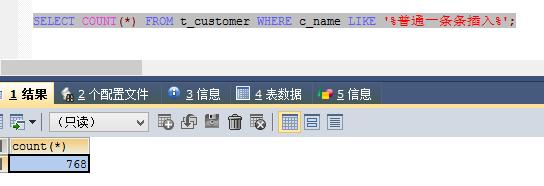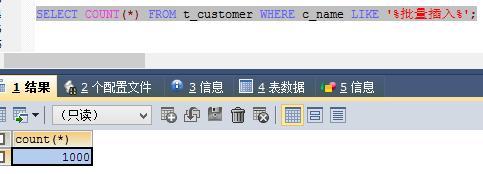mybatis學習之路----mysql批量新增資料
阿新 • • 發佈:2019-01-10
mybatis學習之路----批量更新資料
接下來兩節要探討的是批量插入和批量更新,因為這兩種操作在企業中也經常用到。
mysql新增語句
insert into 表名(欄位,欄位。。。) values ( 值,值 。。。);此種適合單條插入。
批量插入,
一種可以在程式碼中迴圈著執行上面的語句,但是這種效率太差,下面會有對比,看看它有多差。
另一種,可以用mysql支援的批量插入語句,
insert into 表名(欄位,欄位。。。) values ( 值,值 。。。),( 值,值 。。。),( 值,值 。。。)....
這種方式相比起來,更高效。
下面開始來實現。
<!-- 跟普通的insert沒有什麼不同的地方 ,主要用來跟下面的批量插入做對比。--> <insert id="insert" parameterType="com.soft.mybatis.model.Customer"> <!-- 跟自增主鍵方式相比,這裡的不同之處只有兩點 1 insert語句需要寫id欄位了,並且 values裡面也不能省略 2 selectKey 的order屬性需要寫成BEFORE 因為這樣才能將生成的uuid主鍵放入到model中, 這樣後面的insert的values裡面的id才不會獲取為空 跟自增主鍵相比就這點區別,當然了這裡的獲取主鍵id的方式為 select uuid() 當然也可以另寫別生成函式。--> <selectKey keyProperty="id" order="BEFORE" resultType="String"> select uuid() </selectKey> insert into t_customer (id,c_name,c_sex,c_ceroNo,c_ceroType,c_age) values (#{id},#{name},#{sex},#{ceroNo},#{ceroType},#{age}) </insert> <!-- 批量插入, --> <insert id="batchInsert" parameterType="java.util.Map"> <!-- 這裡只做演示用,真正專案中不會寫的這麼簡單。 --> insert into t_customer (id,c_name,c_sex,c_ceroNo,c_ceroType,c_age) values <!-- foreach mybatis迴圈集合用的 collection="list" 接收的map集合中的key 用以迴圈key對應的屬性 separator="," 表示每次迴圈完畢,在sql後面放一個逗號 item="cus" 每次迴圈的實體物件 名稱隨意--> <foreach collection="list" separator="," item="cus"> <!-- 組裝values物件,因為這張表的主鍵為非自增主鍵,所以這裡 (select uuid()) 用於生成id的值--> ((select uuid()),#{cus.name},#{cus.sex},#{cus.ceroNo},#{cus.ceroType},#{cus.age}) </foreach> </insert>
實體model物件
package com.soft.mybatis.model; /** * Created by xuweiwei on 2017/9/10. */ public class Customer { private String id; private String name; private Integer age; private Integer sex; private String ceroNo; private Integer ceroType; public String getId() { return id; } public void setId(String id) { this.id = id; } public String getName() { return name; } public void setName(String name) { this.name = name; } public Integer getAge() { return age; } public void setAge(Integer age) { this.age = age; } public Integer getSex() { return sex; } public void setSex(Integer sex) { this.sex = sex; } public String getCeroNo() { return ceroNo; } public void setCeroNo(String ceroNo) { this.ceroNo = ceroNo; } public Integer getCeroType() { return ceroType; } public void setCeroType(Integer ceroType) { this.ceroType = ceroType; } @Override public String toString() { return "Customer{" + "id='" + id + '\'' + ", name='" + name + '\'' + ", age=" + age + ", sex=" + sex + ", ceroNo='" + ceroNo + '\'' + ", ceroType='" + ceroType + '\'' + '}'; } }
介面
int add(Customer customer);
int batchInsert(Map<String,Object> param);實現
測試類/** * 新增資料 * @param customer * @return */ public int add(Customer customer) { return insert("customer.insert", customer); } /** * 批量插入資料 * @param param * @return */ public int batchInsert(Map<String,Object> param) { return insert("customer.batchInsert", param); } /** * 公共部分 * @param statementId * @param obj * @return */ private int insert(String statementId, Object obj){ SqlSession sqlSession = null; try { sqlSession = SqlsessionUtil.getSqlSession(); int key = sqlSession.insert(statementId, obj); // commit sqlSession.commit(); return key; } catch (Exception e) { sqlSession.rollback(); e.printStackTrace(); } finally { SqlsessionUtil.closeSession(sqlSession); } return 0; }
@Test
public void add() throws Exception {
Long start = System.currentTimeMillis();
for(int i=0;i<1000;i++){
Customer customer = new Customer();
customer.setName("普通一條條插入 "+ i);
customer.setAge(15);
customer.setCeroNo("000000000000"+ i);
customer.setCeroType(2);
customer.setSex(1);
int result = customerDao.add(customer);
}
System.out.println("耗時 : "+(System.currentTimeMillis() - start));
}
@Test
public void batchInsert() throws Exception {
Map<String,Object> param = new HashMap<String,Object>();
List<Customer> list = new ArrayList<Customer>();
for(int i=0;i<1000;i++){
Customer customer = new Customer();
customer.setName("批量插入" + i);
customer.setAge(15);
customer.setCeroNo("111111111111"+i);
customer.setCeroType(2);
customer.setSex(1);
list.add(customer);
}
param.put("list",list);
Long start = System.currentTimeMillis();
int result = customerDao.batchInsert(param);
System.out.println("耗時 : "+(System.currentTimeMillis() - start));
}兩種都進行插入1000條測試
由於我沒有用連線池等等原因,在插入了700多條的時候 junit直接掛了,
Cause: org.apache.ibatis.executor.ExecutorException: Error selecting key or setting result to parameter object.
Cause: com.mysql.jdbc.exceptions.jdbc4.MySQLNonTransientConnectionException:
Data source rejected establishment of connection, message from server: "Too many connections"
資料庫插入結果:
但是第二種僅僅用了2秒多就ok了。可見這種效率很高。
資料庫結果
這裡寫了兩個,其實第一種僅僅是做對比效率用。
批量新增資料記錄完畢。




